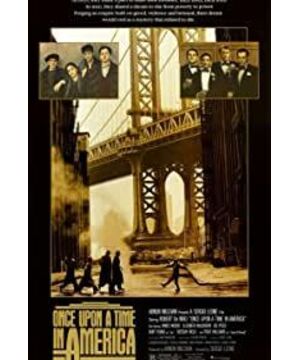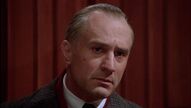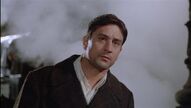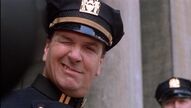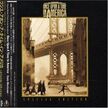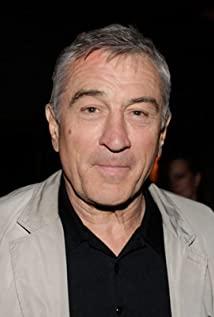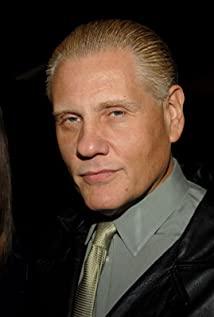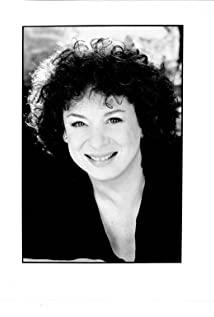Perhaps with the aid of K. Mets’ theory of large combination segments [SP for short, see Metz’s "Movie Language"], we can take a closer look at " "Once Upon a Time in America" has a rather complicated narrative and meaning structure in the 3-hour and 40-minute movie (European version).
1. The prologue non-sequential combination period. In 1993, on the night of the repeal of Prohibition, the police and bandits chased and killed the young Norders. (Insert paragraph: Three brothers violent corpses on the street on a rainy night. Insert scene: Whistleblower's phone.) Norders ran away from home. (Scene 1~14)
2. In 1968, the old man Nuders was recalled by a mysterious tomb relocation notice and met Fatty Mo. (Scene 15-18)
3. In 1921, the teenager Norders spied on Debra dancing in the Fatty Mo restaurant, and was robbed of him by the latter. (Scene 19-21)
4. Scene Norders leads the little brother to burn down the newsstand on behalf of the landlord Bagsey. (Scene 22)
5. The little brothers wanted to rob a drunkard and get on the ground for Max who had just arrived. (Scene 23 ~ 24).
6. Interlude Nuders reads in the toilet, entangled with the washerwoman Page. (Scene 25)
7. Paragraph Norders met Max on the street and became friends. (Scene 26)
8. Interlude passages Patrick and Page. (Scene 27-28)
9. The passages Norders and Max "catch rape", blackmail the inspector, and "take over" Page. (Scene 29)
10. On Sunday, Norders is dating Debra, interrupted by Max. (Scene 30~31)
11. Paragraph Max and Norders were threatened and beaten by Bagsey and his thugs. (Scene 32)
12. Scene Debra shuts out Norders. (Scene 33)
13. Paragraph Max and Norders participated in the smuggling of bootleg alcohol and succeeded. (Scene 34~35)
14. Paragraph Max establishes a fund. (Scene 36~37)
15. Combine with Bagsey, Dominic is killed, Norders kills Bagsey and goes to jail, and Max waits to see him off. (Scene 38~39)
16. Combination section In 1968, Norders visited the new tomb and recovered a huge sum of money and an inexplicable "contract" from the original deposit fund. (Scene 40~42)
17. Combination section In 1933, Norders was released from prison. Reunited with Max and others, reunited with Debra, and met "Frankie" and John. (Scene 43~47)
18. Combination of the diamond robbery (Nuders rape of Kahlo). Hunt down John. Norders’ reaction to this. (Scene 48~53)
19. Scene In 1968, Norders saw the chairman of the local trade union O'Connor on the bar TV and learned about the case of Minister Bailey. (Scene 54)
20. Alternating narrative combination segment In 1933, a politician was hired to protect the labor movement leader O'Connor. The police station stepped in to suppress. Max and others took the Secretary's only son hostage. Interlude: Yu Kahlo. (Scene 54~58)
21. Interlude combination segment Nordles and Debra dating. The latter wanted to go to Hollywood, and Norders raped her in despair. Debra left. (Scene 59~63)
22. Continue to assist union leaders. Argued with Max and went to Florida together. (Scene 64~70)
23. Scene Max insists on robbing the Federal Reserve Bank. (Scene 71)
24. The scene where Norders conspired with Kahlo. (Scene 72)
25. The combination section lifts the night of Prohibition. Max is ready to act. Norders informs. (Scene 73-78)
26. Scene: In 1968, the Charity Institute visited Kahlo. (Scene 79)
27. The combination section visits Debra and learns the answer. (Scene 80~81)
28. The non-sequential combination segment reunites with Secretary Max/Berry. Insert: Memories of 1921. Bailey suicided. Norders has returned to the night when Prohibition was lifted in 1933. (Scene 82~85)
29. Ending scene 1933, Chinese Theater. (Scene 86)
From the analysis of this combined segment, it is not difficult to see that "Once Upon a Time in America" is a very typical film with an interlaced structure of time and space. Time and space are intertwined, but it is not the so-called mental or stream-of-consciousness structure. The film is based on the protagonist Norders' realistic behavior line, during his return to the hometown in 1968, and restores a past event based on his psychological clues. In fact, this past event is composed of two major periods of time, 1921 and 1933, which are extremely complete. Different from "Wild Strawberry" or "Eight and a half" ["Wild Strawberry" is the business card of Swedish director Bergman, "Eight and a half" is the business card of Italian director Fellini. All are the psychological structure of interlaced time and space], the plot clues in the film can be restored into a linear chronological narrative chain. However, it is this rather complicated narrative structure of time and space that is stained with memories of the past, with a past, inevitable sadness and creative sentiment, and at the same time strengthens the narrative tension of the realistic behavior line. And suspense. More importantly, the interlaced structure of time and space gives the viewer a psychological experience that accompanies Norders through 47 years of long life. In fact, the "American Past" presented in the film is only two very short and concentrated memories of Norders's 1921 and 1933. The narrator omitted Norders’ 12 years of behind bars and 35 years of exile. In other words, "all" of Norders' memory in the film revolves around Max, based on the premise of spending time with Max. If it is said, this is not really all the memories of Norders, but at least all his valuable memories. For Norders, the days when Max is away are just living and stealing. As a result, this story composed of Norders’ film-like self-knowing point of view, in a sense, becomes a story about Max provided by the side-knowing point of view.
It is in this narrative of a person with a double protagonist that the film establishes the "dialogue between the analogy structure and the independent structure" of the classic film, that is, "the dialogue between the observation as a character and the observation of the character"[〔〔〕 United States] Nick Brown: "Story and Description", "Film Narrative Rhetoric", University of New Jersey Press, 1981]. This is not only in the narrative of the first-person self-aware viewpoint in the movie, but also a mixture of subjective first-person and objective third-person—the camera is impossible to "Lake on the Lake" ["Lake on the Lake", USA, 1936. In the film, a first-person film narrative is tried, using a camera lens instead of the eyes of the protagonist to observe and present everything. The film failed in both reviews and box office] completely replaced the eyes of the protagonist/narrator, but in the subjective first-person/viewpoint lens/analogous structure and objective third-person/presentation of characters and spatial environment/independent structure The knitting room unfolds. Therefore, the imaginary audience in a film (or "the audience in the text" [[美]Nick Brown: "The audience in the text"," University of New Jersey Press, 1981, the translation was published in "Contemporary Cinema", 1989 Year 3]) is not simply determined or restricted by the person’s point of view and the camera position. He is often more like a dreamer who is in multiple places at the same time, a diversified subject [〔美〕Nick Brown: "The Audience in This Article", University of New Jersey Press, 1981. The translation was published in "Contemporary Movies", No. 3, 1989]. In "Once Upon a Time in America", the dialogue between the analogy structure and the independent structure is not only the basic narrative language of the classic film, but also an important rhetorical method of the film. It is the most fascinating and most fascinating part of this film. In fact, this is a story about betrayal and betrayal, and until the 27th segment, the audience has been effectively and effectively organized in the narrative of Norders' personal and viewpoint. Therefore, until the end of the film, what the audience experienced was a friendship story of life and death in the rivers and lakes. In a sense, the analogy structure in the film shows Norders’ mental perspective. The most typical example is Combination 23. In Norders’ point-of-view lens, Max walks alone on the seashore in the depth of field. The picture frame is like an invisible cage, presenting Max as a crazy trapped beast. The background is the unclear sea and sky, low-flying seagulls, and the sea breeze stirs Max's white silk clothes, making his image seem thin, hopeless and helpless. In fact, this is the prelude to Max's "Grand Slam Action" and the official implementation of his "biggest action in his life". And for his reality is also the biggest obstacle to the soul- Norders, this is undoubtedly a successful performance. The independent structure in the film is an objective presentation, always showing the ruthless reality before the audience. However, it must wait until the end of Norders' homecoming trip, when his memory is overturned and his life rewritten, the truth vaguely reveals in the audience's retrospective.
In fact, every important combination of the film contains an incident of Max’s teasing, manipulation, deception or betrayal of Norders, and the end of each combination is presented as a classic, A scene of irritating male friendship (combination paragraphs 7, 11, 15, 18, 22). Therefore, film narrators use Norders as the center of space, vision, and meaning to successfully wrap and conceal the truth, so that the audience will turn a blind eye and deaf ears like Norders, and always be in the illusion or reality of the soul. . The most obvious example is when the teenager Norders got the first opportunity to approach his goddess Debra, and it was obviously a proud girl who took the initiative to show love, but was watched by Max and interrupted in a very rascal manner. , But next, they were threatened and beaten by the villain Bagsey. When the gangster walked away, in the overhead shot, two blood-stained children fell on the ground in the poor streets and crawled towards each other, trying hard to hold the hands together. This life-and-death situation not only caused the audience to forget and forgive the previous Max, but also made us ignore the following scenes: Debra endured tears in her eyes and refused to open the door for the injured Nordles-soon Previously, this door was opened to Norders. In the passages of 1933, the disagreements and conflicts between Norders and Max continued to occur, but every appearance of friendship succeeded in closing the rift. During a diamond robbery, Norders, full of disgust, rushed the car across the dock and drove into the water, but at the end, the four brothers surfaced and laughed at each other. When the disagreement between Norders and Max intensified and the politicians who hired them clearly mentioned "cleaning", Norders ran away, but just when the elevator he was riding on reached the ground floor, another elevator failed. The light came on and the iron door opened, and Max walked out. He almost embarrassedly said, "Hey, I thought about it, and I went to Florida." This knowing scene seemed to tell people, even if it was Disagreements in the rules of life, it is impossible to separate this pair of best friends. However, in the independent structure of the image, we not only shared the camera's observation of Norders, but also partially learned the truth that was independent of the mileage of Norders' heart. In the scene of the successful smuggling of alcohol in Combination Section 13, we see Norders surfacing anxiously shouting Max, agreeing with the former’s concern about the latter, but at this moment, there is a picture on the upper left side of the screen. The paddling arm was approaching the boat, and that was undoubtedly Max. As for the combination section 22 discussed earlier, when Norders and Max walked out of the two elevators and met in the lobby, a man in a black leather jacket and a leather hat was entering the picture from the bottom edge of the picture. After noticing Norders, he immediately dodged between the two elevators, and what we saw was always a black back. On the visual level, this back figure serves as a black block in the center of the picture, separated between Norders and Max, indicating that the two are close together. On the narrative level, this man in black is undoubtedly an accomplice in Max's despicable plan. But like Norders, we ignore these clues in the identification of Norders' mind.
Although this is a story about deceit and betrayal, the narrator does not present Norders as a foolish or mentally retarded child. He always perceives the facts and truth in his own way. He even clearly inferred Max’s behavioral logic: “Today they hired you to kill John, and tomorrow they might let me kill you. Maybe you can do this, but I can’t.” He also saw Max clearly. With his ever-expanding ambitions, he ridiculed Debra, who is dedicated to being a master: "I heard Max's voice from your mouth." He even told Max: "When you want to clean me, let me know." But he was right. Max's insight cannot surpass the myth of brotherhood. What he can never imagine is that when the purge comes, there will be no "notifications", no warnings, and even a moment before the implementation of Max’s big action, in Norders’ point of view, it is still Mike. The three Si brothers embraced together and went through a dangerous situation together. When he faced this fact, it still wrapped the appearance of "when life is different, death is the same hole". In the prologue of the heavy rain, the corpses of the three Max brothers lined up on the street. I’m so painful that I can’t recognize me.” Like Norders, at this moment, the audience must have ignored the corpse with the “Max” identification tag, just an unknown dead with a charred face. ). In the luxurious tomb, the panning lens as the viewpoint of Norders reveals the inscriptions on the white marble tombstone in turn: the death period is the same year and the same moment. "Do not seek to be born in the same year and on the same day, but to die on the same day and the same month." It seems that except for Norders, they have all fulfilled their promise of friendship by the fact that they died suddenly in Huanian. Only Norders is a cowardly survivor. ——Until another living person who borrowed a corpse to resurrect his life shows up.
Another important narrative rhetoric strategy in the film is to effectively hide Max’s point of view in Norders’ first-person narrative. In the process of watching the film, people have no doubt that, like the original, this is an "autobiographical" film. The storytelling and the presentation of events are not only internally limited to Norders’ viewpoint (witnessing, presence) [see author: "Film and Viewpoint Narrative", a correspondence teaching material of the Department of Literature of Beijing Film Academy. The author believes that the scene presented by the personal narrative in the film must be based on the presence and witnessing of the character], and as a memory of Norders, it is also infiltrated by Norders' sadness and reminiscence. In fact, this is only presented by the analogy structure of the image, and in the independent structure of the image, there is always Max’s viewpoint lens. In some important scenes, it is Max’s viewpoint lens instead of Norders’ viewpoint. The agent of the narrative. As early as Max broke into the world of Norders for the first time, the narrator has given Max a superior point of view: an overhead view shot from a high place—the top of Max’s carriage, which captures Norder’s Si and his little brother appear as a group of sneaky and difficult-to-achieve street wanderers. At the same time, the vertical cut shot between Max and Norders has confirmed the relationship between power and position in the future. But the extremely secret scene of the first date between Norders and Debra was exposed to the sight of the peeper Max.
In the combination section 15, at the end of the 1920s story, there is an important lens section implied, which contains a reversal of the viewpoint lens [see the author: "The Opposite Shot and Film Narrative", "Film Creation" 1991 Year 3. The author believes that the distribution of viewpoints and shots in film narration, as Foucault has discussed, is the distribution of discourse power in social life; in other words, the viewpoint and discourse power in movies are equivalent. ]. After the prisoner escorting Norders slowly passing the panoramic view of the corner of the street, it was a close-up shot of Norders behind the bars of the prisoner car, and he looked at the distance out of the window with attachment. The counter-attack was his long-term perspective. Under the high wall opposite the prison, the three brothers of Max were standing there, and Fatty Mo also hurried over. Switching to the close-up shot of Norders again, with tears in his eyes, he tried to show a smile to his friends. Point of view/anti-shooting: The camera slowly pans to take pictures of the four brothers in need in the distant scene, an infinite and affectionate stare of Norders and a nostalgic farewell. A close shot of Norders appeared for the third time, and he raised his hand to wave goodbye to his friends. When Max and the others in the distant scene were hit again, the picture was with the prison bars and the hand waving goodbye from Norders as the foreground. But next, it was the prison car in the panorama, which seemed to be an objective statement lens. But after that, Max’s close-up shot defines Max’s point of view in the previous shot. Fight back: The prison car drove slowly into the prison, and the heavy iron gate seemed to be closed in front of us. Switch to Max's close-up again, and the camera gradually moved to a close-up. In this long shot, Max raised his eyes with understanding and cast his gaze to the unknown place in the distance. This is not only a moment of reversal of perspective, but also a moment of reversal of meaning, and at the same time a turning point in Max's mental journey. At this moment, Max denied the road of street gangsters/gangsters from the experience of Norders. There are only two destinations on this road-one is the street with corpses like Bagsey, and the other is Noord. He went to jail like a slam. This is undoubtedly the specific presentation of the film narrator and the independent lens of the image: because at this time, the narrator/Nudels in the narrative is no longer on the scene, he has been closed behind the iron gate, which will take 12 years It will be opened to him later. However, this obvious Max’s point of view lens was once again successfully obscured in the text. Next, is the golden inscription on the white marble tomb in the shot upwards: "You young and strong will fall under the sword." It seems to be Max's vision in the previous shot. But the camera reversed, and the picture showed the old Norders in 1968, looking up at the inscription with mixed emotions.
The more important one is the tragic night of the lifting of Prohibition (combination paragraph 25). In fact, this passage begins with a large close-up of Max. In this shot, Max's face is mostly hidden in the shadows, only his eyes flashing coldly. The visual narrative of this passage establishes the gazes of three people intertwined and avoiding each other. The first is the anxious and guilty Norders, who refuses to exchange eyes with anyone. In order to fulfill the promise of concentric life and death, in order to save his "crazy" friend, he must do his most shameless deed: inform the police. The second is Carol's anxious and concealed gaze. She turned her gaze to Norders time and time again, urging him to do what he "should do". The most important thing is Max's keen and seemingly nonchalant gaze. The gaze and behavior of Nordles and Carol are always under the surveillance and control of this gaze. Max is like a director, supervising the execution of every detail of this repertoire. In fact, even the collusion between Norders and Carol and Norders’ whistleblower are part of Max’s actions and plans. It was from his subtle hint that Carol got "inspiration" and made suggestions to Norders. (The so-called "I got this idea from your friend. He always makes fun of you, saying that every time you pass here, you have to wet your pants, saying that you always try to get the police on guard, so that you can't do this." This action.”) So, through Norders, Max will use the police to wipe out all his companions and seize their property without showing a trace. At the same time, he successfully “eliminates” the bootlegger and the gang Max. So that he can change his head and make a good progress. In this passage, it was Carol's gaze that obscured Max's point of view and his true motives. At this moment, the audience tends to refer to Max's gaze as a certain doubt in the identification of Norders' viewpoint and the independent structure of the image. In fact, when Norders made up his mind and walked to the office, it was Max who watched him until he closed the door behind him. He waited until there was enough time before Max knocked on the door. He walked into the room and seemed to straighten the phone receiver that Norders had hung up in a panic. At this time, he was completely relieved: everything was foolproof. The film "Once Upon a Time in America" has thus become a fascinating story, a myth about the United States, and at the same time it has become a dismantling of the American myth.
View more about Once Upon a Time in America reviews


